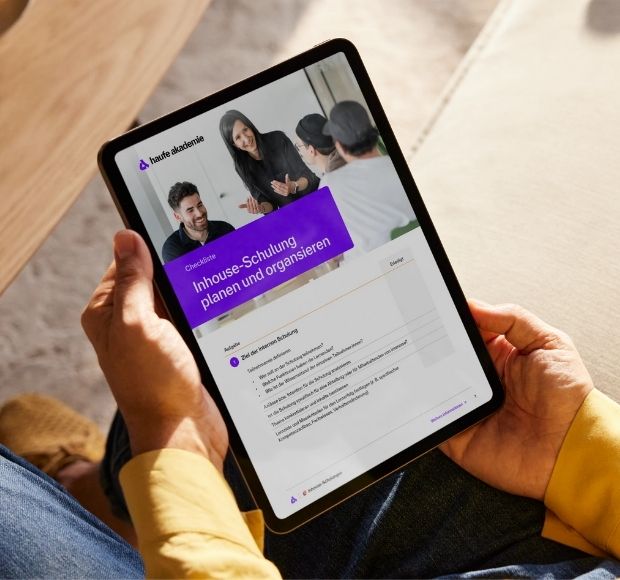How can in-house training courses be organized efficiently? Seminars often have to be postponed or canceled - either because demand has changed, the date no longer fits or the wrong training courses were advertised internally during annual planning, resulting in low registration numbers. This not only costs money, but also eats up time and valuable resources. With concrete, well thought-out demand planning, you can meet these challenges at an early stage and successfully implement your training courses.
In this article, you will learn how to plan and organize in-house training courses - including a practical ► checklist to help you keep track of everything.
The biggest challenges in planning in-house training courses
Before you go into the detailed planning of your further training, you should be aware of possible stumbling blocks. One common problem is a lack of flexibility. Training courses are often scheduled at the beginning of the year, but the demand for training can change over time. Cancellations or postponements due to too few participants are the result. The solution? Rely on customized training courses that are individually tailored to the current needs of your teams. This allows you to react at short notice and ensure that the seminars really meet the requirements.
Planning in-house training: Successful step by step
A well-thought-out plan is the be-all and end-all for avoiding rejections and meeting actual needs. Don't just think long-term, but also define learning objectives and target groups precisely.
Step 1: Define target group and learning objectives
Annual planning for the entire workforce or specific training for a specialist department? First consider who should take part in the training and what knowledge or skills need to be imparted. Managers play a decisive role here, as they often know the requirements of their teams best. The individual needs of employees or project teams should also be taken into account - especially when new systems or processes are being introduced.
Practical tip:
Employee appraisals at the end of the year are a particularly good opportunity to identify training needs. Managers can provide important information on new areas of development that come up in discussions with their employees. Involve them in the needs analysis at an early stage in order to address the requirements in a targeted manner.
Step 2: Plan your budget cleverly
Once the target group has been defined, the budget planning follows. In addition to the direct training costs, hidden expenses such as possible overtime or the absence of employees during the training period should also be planned for. A realistically calculated budget creates financial leeway and prevents bottlenecks.
Practical tip:
Plan reserves for unforeseen changes. It often only becomes apparent during the course of the year that additional training is required or content needs to be adapted. A flexible budget buffer allows you to react to such changes without running into financial bottlenecks.
Step 3: Develop the right training concept
The next step is to select the right format for the training. Face-to-face events, online training or a hybrid model(blended learning) each offer different advantages. Depending on the objectives and the locations of the participants, it also makes sense to combine different formats. Online training, for example, offers the flexibility to bring employees from different locations together without the need to travel. This not only saves you time, but also costs for travel and accommodation. On-site, you promote direct exchange and interaction and can strengthen team spirit with practical exercises.
Practical tip:
When balancing budget and training concept, cuts should not be made at the expense of learning objectives. If seminars are shortened to save money, important content may be lost. Set clear priorities: Which topics are essential? Virtual training can be just as practical - face-to-face formats are ideal for exercises, while theoretical content can be taught efficiently online.

In-house training on site or online
Build up targeted expertise with the widest range of in-house training courses on the market. Exclusively for your employees and optimally adapted to the needs of your company.
In-house training
Organize in-house training courses: Step by step
Once the planning has been completed, it's time to organize the training in practice. The following steps will help you with this.
Step 4: Select provider and trainer
A good training provider is crucial for the success of the training. Make sure that they have experience in your specific training area and can provide references. This is because a provider who understands your company and your requirements can offer tailor-made solutions and thus significantly influence the success of the training.
Practical tip:
Take a look at the provider's references and experience reports in advance to get a feel for the quality of previous training courses and to recognize potential stumbling blocks in good time. Also: Think about which trainer personality fits in well with your corporate culture - this can have a significant impact on the success of the training.
Step 5: Determine training date and procedure
A well-planned appointment with a clear schedule is crucial for successful training. This is less about the content, which is organized by the trainer , and more about finding the right time: When do the participants have capacity, and does the date fit into the company's schedule? The process also needs to be well coordinated - who receives the trainer , are all participants on site or do they have access to the virtual platform? These organizational details ensure that the training runs smoothly and that there is room for discussion and questions.
Practical tip:
"I have one more question!" - It is precisely moments like these that often make training courses lively and practical. Obtain the wishes and topics of the participants in advance and pass them on to the trainer . This way, individual concerns can be integrated into the training in a targeted manner.
Step 6: Prepare the training location
The training room should be carefully prepared. In addition to a pleasant room design, it is important that the technical equipment works perfectly. The seating arrangement can also have a decisive influence on the success of the training course. An open seating arrangement can encourage interaction, while a classic arrangement provides more structure.
Practical tip:
Together with the:der trainer, consider which seating arrangement best suits the objectives of the training. Checking the technology in advance also saves time and avoids delays at the start of the training.
Step 7: Obtain feedback
There should be an evaluation at the end of every training course. This allows the success of the training to be measured and optimized for future seminars. Direct feedback from participants provides valuable information on how the training can be improved in the future. It is even more valuable to ask for feedback again after a few weeks to check whether the content taught has actually been put into practice.
Practical tip:
Long-term feedback is crucial. Schedule a follow-up training session after a few weeks to ensure that the content taught is applied in practice in the long term. This allows you to address any questions that may still be unanswered and further promote long-term learning success.

Planning in-house training: checklist
To make the planning and organization of in-house training courses even easier, we have created a checklist. It helps you to keep track of all the important steps - from needs analysis to evaluation. Download now and get started right away!
Download checklist




